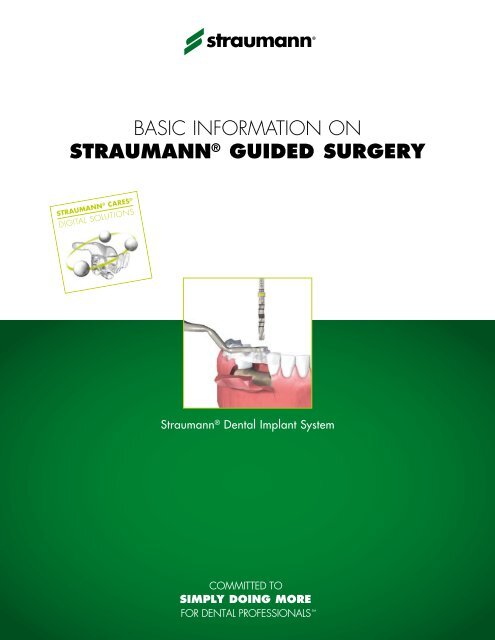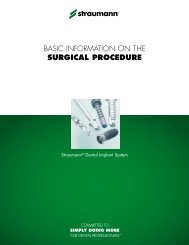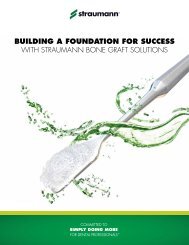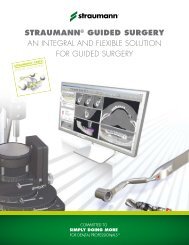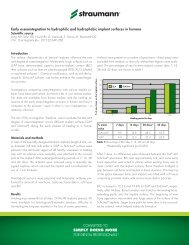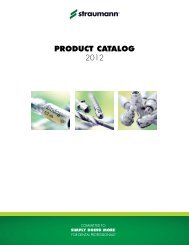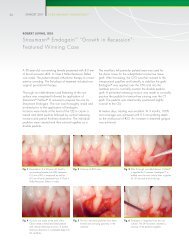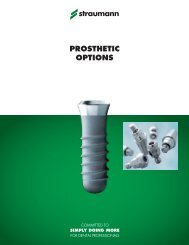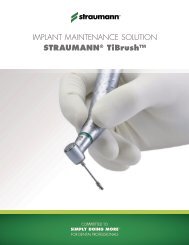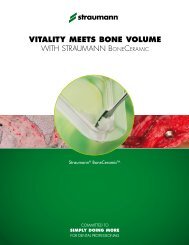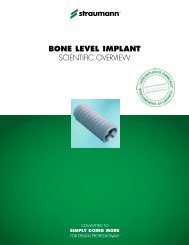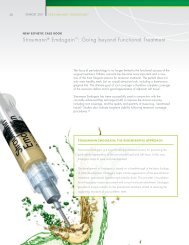Basic information on STRAUMANN® GUIDED SURGERY
Basic information on STRAUMANN® GUIDED SURGERY
Basic information on STRAUMANN® GUIDED SURGERY
Create successful ePaper yourself
Turn your PDF publications into a flip-book with our unique Google optimized e-Paper software.
<str<strong>on</strong>g>Basic</str<strong>on</strong>g> Informati<strong>on</strong> <strong>on</strong><br />
Straumann ® Guided Surgery<br />
Straumann ® Dental Implant System
The ITI (Internati<strong>on</strong>al Team for Implantology) is academic partner of Institut Straumann<br />
in the areas of research and educati<strong>on</strong>.
C<strong>on</strong>tents<br />
About this guide 3<br />
1. Preoperative planning and guided surgery for<br />
Straumann ® Dental Implant System 4<br />
Step 1 – Treatment plan 4<br />
Step 2 – Scan prosthesis fabricati<strong>on</strong> 4<br />
Step 3 – CT scanning 5<br />
Step 4 – Software-based planning and fabricati<strong>on</strong><br />
of the surgical template (open system approach) 5<br />
Step 5 – Surgery with Straumann ® guided instruments<br />
& guided implant inserti<strong>on</strong> 5<br />
Step 6 – Prosthetic procedures 5<br />
2. Planning and clinical soluti<strong>on</strong>s 6<br />
2.1 Surgical template 6<br />
2.1.1 Surgical template fixati<strong>on</strong> 6<br />
2.1.2 Sleeves for surgical templates 7<br />
2.1.3 Sleeve positi<strong>on</strong>s 9<br />
2.1.4 Surgical template fabricati<strong>on</strong> 10<br />
2.1.5 Surgical template pre-processing 10<br />
2.2 Straumann ® Guided Surgery c<strong>on</strong>cept 11<br />
2.2.1 Drill handles for basic implant<br />
bed preparati<strong>on</strong> 11<br />
2.2.2 C-handles for final implant bed preparati<strong>on</strong> 13<br />
2.2.3 The surgical protocol for guided surgery 14<br />
2.2.4 Straumann ® guided implants 15<br />
2.2.5 Straumann ® Guided Surgery Cassette 16<br />
2.2.6 Precauti<strong>on</strong>s 17<br />
3. Surgical procedures 18<br />
3.1 Use of the mucosa punch 18<br />
3.2 <str<strong>on</strong>g>Basic</str<strong>on</strong>g> implant bed preparati<strong>on</strong> for situati<strong>on</strong>s with<br />
sufficient interdental space 19<br />
3.3 <str<strong>on</strong>g>Basic</str<strong>on</strong>g> implant bed preparati<strong>on</strong> for narrow<br />
interdental spaces 26<br />
3.4 Final implant bed preparati<strong>on</strong> 28<br />
3.4.1 Profile drilling for situati<strong>on</strong>s with sufficient<br />
interdental space 29<br />
3.4.2 Tapping for situati<strong>on</strong>s with sufficient<br />
interdental space 31<br />
3.4.3 Overview guided instruments for final<br />
implant bed preparati<strong>on</strong> 34<br />
3.5 Guided implant placement 35<br />
3.5.1 Opening the implant package 35<br />
3.5.2 Placing the implant 35<br />
3.6 Soft tissue management 39<br />
4. Product specificati<strong>on</strong>s 40<br />
4.1 Sleeve-positi<strong>on</strong> implant-length matrix 40<br />
4.1.1 Sleeve-positi<strong>on</strong> implant-length matrix for<br />
Ø 5.0 mm sleeves in the surgical template 40<br />
4.1.2 Sleeve-positi<strong>on</strong> implant-length matrix for<br />
Ø 2.8 mm sleeves ( narrow interdental spaces)<br />
in the surgical template 40<br />
4.2 Straumann ® guided drill design 41<br />
4.3 Color-coding and labeling of Straumann ® cutting<br />
instruments for guided surgery 42<br />
4.4 Overview of cutting instruments for guided surgery<br />
with depth c<strong>on</strong>trol 43<br />
4.5 Overview of guided implants 44<br />
4.6 Surgical protocol template for completing manually<br />
(to be copied) 45<br />
5. Additi<strong>on</strong>al <str<strong>on</strong>g>informati<strong>on</strong></str<strong>on</strong>g> 46<br />
5.1 Additi<strong>on</strong>al <str<strong>on</strong>g>informati<strong>on</strong></str<strong>on</strong>g> <strong>on</strong> surgical instruments 46<br />
5.2 Care and maintenance of instruments 47<br />
5.3 Labeling and color-coding of the Straumann ®<br />
Dental Implant System 48<br />
5.4 Related documentati<strong>on</strong> 50<br />
5.5 Important guidelines 52<br />
6. Index 54
About this guide<br />
The <str<strong>on</strong>g>Basic</str<strong>on</strong>g> Informati<strong>on</strong> <strong>on</strong> Straumann ® Guided Surgery for the Straumann ® Dental<br />
Implant System provides dental professi<strong>on</strong>als and related specialists with the<br />
essential steps for surgical treatment planning, and procedures for guided surgery.<br />
The manual is divided into the following main parts:<br />
Preoperative planning and guided surgery for Straumann Dental Implant system<br />
Planning and clinical soluti<strong>on</strong>s<br />
Surgical procedures<br />
Product specificati<strong>on</strong>s<br />
Additi<strong>on</strong>al <str<strong>on</strong>g>informati<strong>on</strong></str<strong>on</strong>g><br />
The following <str<strong>on</strong>g>informati<strong>on</strong></str<strong>on</strong>g> is not sufficient to allow immediate use of the Straumann<br />
Dental Implant System. Knowledge of dental implantology and instructi<strong>on</strong> in the<br />
handling of the Straumann Dental Implant System provided by an operator with the<br />
relevant experience and by the brochure for c<strong>on</strong>venti<strong>on</strong>al procedures “Straumann<br />
Dental Implant System: <str<strong>on</strong>g>Basic</str<strong>on</strong>g> Informati<strong>on</strong> <strong>on</strong> the Surgical Procedures” (USLIT 100)<br />
are always necessary. For detailed <str<strong>on</strong>g>informati<strong>on</strong></str<strong>on</strong>g> <strong>on</strong> products supplied by third<br />
parties, please c<strong>on</strong>tact these companies directly.<br />
Please note that not all products are available in all markets.<br />
Please c<strong>on</strong>tact your local Straumann representative for more details.<br />
3
1. Preoperative planning and guided surgery for Straumann ® Dental Impla<br />
Straumann ® Software system<br />
Open<br />
1. Treatment plan 2. Fabricati<strong>on</strong> scan prosthesis 3. CT scanning 4. Software based planning<br />
Straumann ® guided instruments are intended for<br />
treatments planned preoperatively with 3D planning<br />
software. They are designed to prepare the implant<br />
bed for implants of the Straumann ® Dental Implant System<br />
using surgical templates.<br />
The Straumann ® planning software complementing the<br />
Straumann ® guided instruments is called coDiagnostiX .<br />
For further <str<strong>on</strong>g>informati<strong>on</strong></str<strong>on</strong>g>, please c<strong>on</strong>tact your Straumann<br />
representative. However, the open system approach also<br />
allows for the executi<strong>on</strong> of template-based surgery<br />
preoperatively planned with other planning software<br />
systems. For further <str<strong>on</strong>g>informati<strong>on</strong></str<strong>on</strong>g>, please c<strong>on</strong>tact your<br />
Straumann representative.<br />
Computer Guided (Static) Surgery can be subdivided into<br />
six main steps (see figure above). They are described in the<br />
following.<br />
Step 1 – Treatment plan<br />
Diagnosis and patient specific requests influence the treatment<br />
plan. The type of final restorati<strong>on</strong>, patient’s request for<br />
a provisi<strong>on</strong>al, number of implants and imaging procedure<br />
need to be taken into account for the patient’s treatment<br />
plan for guided surgery.<br />
Note<br />
For a template based surgery, the patient’s mouth opening<br />
capability needs to be sufficient to accommodate the<br />
instruments for guided surgery.<br />
Step 2 – Scan prosthesis fabricati<strong>on</strong><br />
The scan prosthesis is a radiopaque duplicate of the current<br />
situati<strong>on</strong> or the provisi<strong>on</strong>al teeth set-up. It supplies the clinician<br />
with additi<strong>on</strong>al <str<strong>on</strong>g>informati<strong>on</strong></str<strong>on</strong>g> for implant planning.<br />
When the patient is scanned with the scan prosthesis, the<br />
desired tooth set-up is visible in the CT images.<br />
The scan prosthesis is also used to visualize the soft tissue<br />
situati<strong>on</strong> in the planning software. Furthermore, reference<br />
marks (e.g. Guttapercha) are incorporated in the scan<br />
prosthesis for the identificati<strong>on</strong> of its positi<strong>on</strong> in the planning<br />
software.<br />
The procedure for fabricating the scan prosthesis is<br />
dependent <strong>on</strong> applied software and chosen template<br />
fixati<strong>on</strong> (b<strong>on</strong>e, teeth or mucosa supported). Refer to the<br />
detailed documentati<strong>on</strong> of the software suppliers for further<br />
<str<strong>on</strong>g>informati<strong>on</strong></str<strong>on</strong>g>.<br />
4<br />
1. Preoperative planning and guided surgery for Straumann ® Dental Implant System
nt System<br />
system<br />
Fabricati<strong>on</strong> surgical template 5. Surgery with Straumann ®<br />
6. Prosthetic procedures<br />
guided instruments<br />
Step 3 – CT scanning<br />
Regardless of imaging technology used, scanning with<br />
the correct parameters is the basis for accurate planning<br />
in the software and for correct implant placement.<br />
In order to get the optimal scan data, the radiologist and<br />
the patient need to be instructed correctly and scanning<br />
instructi<strong>on</strong>s/parameters must be followed according to the<br />
software supplier guidelines.<br />
Step 4 – Software-based planning and<br />
fabricati<strong>on</strong> of the surgical template (open<br />
system approach)<br />
Software-based planning allows for implants to be planned<br />
virtually within the planning software. When completed<br />
successfully, the case plan is sent to the surgical template<br />
manufacturer. The software company may act as the<br />
surgical template manufacturer or the dental laboratory may<br />
fabricate the surgical template depending <strong>on</strong> the software<br />
c<strong>on</strong>cept used.<br />
Note<br />
In this step, the surgical template manufacturer ensures the<br />
compatibility with the Straumann ® guided instruments by<br />
utilizing Straumann ® sleeves for guided surgery positi<strong>on</strong>ed<br />
according to Straumann parameters.<br />
Step 5 – Surgery with Straumann ® guided<br />
instruments & guided implant inserti<strong>on</strong><br />
After fixing the surgical template in the patient’s mouth,<br />
the implant bed for Standard, Standard Plus, Tapered Effect,<br />
and B<strong>on</strong>e Level implant lines can be prepared with the<br />
guided instruments included in the portfolio of Straumann ®<br />
Guided Surgery Instruments. The surgical protocol, provided<br />
together with the surgical template, recommends which<br />
instruments are required to prepare each implant site. The<br />
Straumann ® guided implants allow for inserti<strong>on</strong> through the<br />
surgical template including a physical depth c<strong>on</strong>trol.<br />
Step 6 – Prosthetic procedures<br />
For the prosthetic procedures, Straumann offers a wide<br />
range of soluti<strong>on</strong>s. The brochures “Straumann ® Narrow<br />
Neck: Prosthetic Opti<strong>on</strong>s for Narrow Neck Implants”<br />
(USLIT 112), “Straumann ® synOcta Prosthetic<br />
System: Crown and Bridge restorati<strong>on</strong>s” (USLIT 187),<br />
“Straumann ® Solid Abutment Prosthetic System:<br />
Cement-retained Crowns and Bridges with the Solid<br />
Abutment System” (USLIT 045) and “Straumann ® B<strong>on</strong>e Level<br />
Implant Line: <str<strong>on</strong>g>Basic</str<strong>on</strong>g> Informati<strong>on</strong> <strong>on</strong> the Prosthetic Procedures”<br />
(USLIT 232) describe in detail the prosthetic workflow for the<br />
respective implants to be restored.<br />
1. Preoperative planning and guided surgery for Straumann ® Dental Implant System<br />
5
2. Planning and clinical soluti<strong>on</strong>s<br />
2.1 Surgical template<br />
2.1.1 Surgical template fixati<strong>on</strong><br />
B<strong>on</strong>e-, mucosa- and teeth-supported surgical template fixati<strong>on</strong>s (see figures below)<br />
are possible depending <strong>on</strong> the clinician’s preferences and the planning system used.<br />
B<strong>on</strong>e-supported Mucosa-supported Teeth-supported<br />
Note<br />
In order to stabilize the surgical template, it can additi<strong>on</strong>ally be fixed with fixati<strong>on</strong><br />
pins (see chapter 3), fixati<strong>on</strong> screws, or it can be positi<strong>on</strong>ed <strong>on</strong> temporary<br />
implants.<br />
6 2. Planning and clinical soluti<strong>on</strong>s
2.1.2 Sleeves for surgical templates<br />
Depending <strong>on</strong> the anatomical situati<strong>on</strong> and the planned<br />
axis of adjacent implants, two different sleeve diameters are<br />
available.<br />
Ø 5.0 mm sleeves for regular situati<strong>on</strong>s with sufficient<br />
space for sleeve placement<br />
5.0 mm inner diameter<br />
Ø 2.8 mm sleeves for narrow interdental spaces<br />
2.8 mm inner diameter<br />
Sleeve collisi<strong>on</strong> due to<br />
inclinati<strong>on</strong> or narrow<br />
interdental space<br />
Use a Ø 2.8 mm<br />
sleeve instead<br />
Furthermore, the sleeves are available in two different<br />
designs:<br />
cylindrical<br />
cylindrical with an additi<strong>on</strong>al rim at the top (T-sleeve)<br />
Which sleeve design is used depends <strong>on</strong> the surgical<br />
template manufacturer. The graphics in this brochure show<br />
the cylindrical sleeves as example (see specificati<strong>on</strong>s in the<br />
following table).<br />
2. Planning and clinical soluti<strong>on</strong>s<br />
7
Article Art. No. Sleeve inner<br />
diameter<br />
Sleeve outer diameter<br />
Sleeve height<br />
Use of drill<br />
handle<br />
Dmin<br />
Ø 5.0 mm<br />
Sleeve<br />
034.050V4 d = 5.0 mm Dmin = 5.7 mm<br />
Dmax = 6.3 mm<br />
Dmax<br />
H = 5.0 mm<br />
yes<br />
d<br />
H<br />
Dmin<br />
Ø 2.8 mm<br />
Sleeve<br />
034.052V4 d = 2.8 mm Dmin = 3.2 mm<br />
Dmax = 3.8 mm<br />
Dmax<br />
d<br />
H = 6.0 mm<br />
no<br />
(Direct guidance of<br />
milling cutters and<br />
H<br />
guided drills<br />
Ø 2.8 mm)<br />
Dmin<br />
Ø 5.0 mm<br />
T-sleeve<br />
034.053V4 d = 5.0 mm Dmin = 5.7 mm<br />
Dcollar = 7.0 mm<br />
Dmax = 6.3 mm<br />
Dcollar<br />
d<br />
H = 5.0 mm<br />
h = 4.5 mm<br />
yes<br />
H<br />
h<br />
Dmax<br />
Dmin<br />
Ø 2.8 mm<br />
T-sleeve<br />
Dcollar<br />
034.055V4 d = 2.8 mm Dmin = 3.2 mm<br />
Dcollar = 4.4 mm<br />
Dmax = 3.8 mm<br />
H<br />
d<br />
h<br />
H = 6.0 mm<br />
h = 5.5 mm<br />
no<br />
(Direct guidance of<br />
milling cutters and<br />
guided drills<br />
Ø 2.8 mm)<br />
Dmax<br />
8 2. Planning and clinical soluti<strong>on</strong>s
2.1.3 Sleeve positi<strong>on</strong>s<br />
The system allows for flexible sleeve placement in the<br />
surgical template. The three distinct sleeve positi<strong>on</strong>s are<br />
2.0 mm (H2), 4.0 mm (H4), 6.0 mm (H6) above b<strong>on</strong>e<br />
level (see figure).<br />
Ø 5 mm sleeve<br />
Ø 2.8 mm sleeve<br />
H2 H4 H6 H2 H4 H6<br />
5.0 mm<br />
sleeve height<br />
2.0 mm<br />
4.0 mm<br />
6.0 mm<br />
6.0 mm<br />
sleeve height<br />
2.0 mm<br />
4.0 mm<br />
6.0 mm<br />
While determining the corresp<strong>on</strong>ding sleeve positi<strong>on</strong> for<br />
each implant in the planning software, the following requirements<br />
need to be c<strong>on</strong>sidered for favorable c<strong>on</strong>diti<strong>on</strong>s during<br />
surgical procedures.<br />
The surgical template fixati<strong>on</strong> (mucosa-, b<strong>on</strong>e- or teethsupported)<br />
and the mucosa thickness determine the<br />
sleeve positi<strong>on</strong>.<br />
The sleeve positi<strong>on</strong> in the surgical template must allow for<br />
ample access for instrument irrigati<strong>on</strong>.<br />
Sleeve c<strong>on</strong>tact with tissue must be avoided.<br />
Notes<br />
Place the sleeve as close to the b<strong>on</strong>e / soft tissue as<br />
anatomic c<strong>on</strong>diti<strong>on</strong>s allow in order to reduce overall<br />
instrument height.<br />
2. Planning and clinical soluti<strong>on</strong>s<br />
9
2.1.4 Surgical template fabricati<strong>on</strong><br />
The surgical template must allow for proper irrigati<strong>on</strong> of the<br />
surgical site. For this purpose, windows can be included in<br />
the surgical template.<br />
For a correct fit of the cylinder of the handles in the sleeve<br />
(see chapter 2.2.1) remove additi<strong>on</strong>al material around the<br />
sleeve.<br />
Cauti<strong>on</strong><br />
Ensure the sleeves are firmly fixed into the surgical<br />
template.<br />
Radial and axial load <strong>on</strong> the sleeves must be avoided to<br />
help ensure proper retenti<strong>on</strong> of the sleeves in the surgical<br />
template and reduce abrasi<strong>on</strong> of the rotating instruments<br />
in the sleeve.<br />
Prior to starting the surgical procedures, evaluate the fit<br />
and stability of the surgical template <strong>on</strong> the model and in<br />
the patient’s mouth as well as size and localizati<strong>on</strong> of the<br />
openings for irrigati<strong>on</strong> after receiving it from the<br />
manufacturer. Verify if the positi<strong>on</strong> and orientati<strong>on</strong> of the<br />
sleeves in the surgical template corresp<strong>on</strong>d with the<br />
preoperative plan. Check product documentati<strong>on</strong> (if<br />
available) from the surgical template manufacturer.<br />
2.1.5 Surgical template pre-processing<br />
For disinfecti<strong>on</strong>/sterilizati<strong>on</strong> of the surgical template before<br />
surgery use an appropriate liquid chemical disinfectant (e.g.<br />
betadine) or a sterilizing agent that follows the instructi<strong>on</strong>s<br />
from the template manufacturer. Do not damage the material<br />
of the surgical template.<br />
10 2. Planning and clinical soluti<strong>on</strong>s
2.2 Straumann ® Guided Surgery c<strong>on</strong>cept<br />
2.2.1 Drill handles for basic implant bed preparati<strong>on</strong><br />
Straumann ® drill handles direct milling cutters and guided<br />
drills based <strong>on</strong> the sleeve-in-sleeve c<strong>on</strong>cept (see adjacent<br />
figure). The cylinder of the drill handle is inserted into the<br />
sleeve (Ø 5.0 mm) fixed to the surgical template. For each<br />
instrument diameter, Ø 2.2 mm, Ø 2.8 mm, Ø 3.5 mm<br />
and Ø 4.2 mm, an erg<strong>on</strong>omic drill handle is available.<br />
Drill handle<br />
with cylinders for<br />
drill guidance<br />
Sleeve<br />
fixed to the surgical<br />
template<br />
Every drill handle features <strong>on</strong>e cylinder with an additi<strong>on</strong>al<br />
height of +1.0 mm at <strong>on</strong>e end and a sec<strong>on</strong>d cylinder with<br />
an extra cylinder height of +3.0 mm at the other end (see<br />
figure below).<br />
+1.0 mm +3.0 mm<br />
∆ 2.0 mm in<br />
osteotomy depth<br />
The surgical protocol (see chapter 2.2.3) lists which cylinder<br />
of the drill handle (+1.0 mm, +3.0 mm) should be used for<br />
each implant.<br />
2. Planning and clinical soluti<strong>on</strong>s<br />
11
For identificati<strong>on</strong> during surgery, Straumann ® drill handles<br />
for guided surgery are color-coded and symbol-marked<br />
(see following figure).<br />
+1 mm<br />
+3 mm<br />
Art. No.<br />
Instrument<br />
diameter<br />
+1.0 mm +3.0 mm<br />
1.0 mm Drill handle<br />
3.0 mm<br />
cylinder<br />
034.150 Ø 2.2 mm<br />
034.250 Ø 2.8 mm<br />
034.450 Ø 3.5 mm<br />
Color-coding<br />
and symbol<br />
034.650 Ø 4.2 mm<br />
12 2. Planning and clinical soluti<strong>on</strong>s
2.2.2 C-handles for final implant bed preparati<strong>on</strong><br />
Straumann ® C-handles for final implant bed preparati<strong>on</strong> are<br />
also designed according to a sleeve-in-sleeve c<strong>on</strong>cept. The<br />
cylinder of the C-handle is inserted into the sleeve (Ø 5.0 mm<br />
<strong>on</strong>ly) fixed to the surgical template. Each C-handle corresp<strong>on</strong>ds<br />
to <strong>on</strong>e distinct sleeve positi<strong>on</strong> (H2, H4 and H6) as<br />
shown in the chart below.<br />
Art. No. Article Sleeve positi<strong>on</strong><br />
034.750 C-handle H2 H2<br />
2.0 mm above b<strong>on</strong>e level<br />
034.751 C-handle H4 H4<br />
4.0 mm above b<strong>on</strong>e level<br />
034.752 C-handle H6 H6<br />
6.0 mm above b<strong>on</strong>e level<br />
The Straumann ® C-handles direct guided profile drills and<br />
guided taps (see figure).<br />
034.752<br />
H2 H4 H6<br />
034.751<br />
034.750<br />
2.0 mm<br />
4.0 mm<br />
6.0 mm<br />
2. Planning and clinical soluti<strong>on</strong>s<br />
13
2.2.3 The surgical protocol for guided surgery<br />
The implant bed preparati<strong>on</strong> with guided instruments follows<br />
the surgical protocol normally delivered together with the<br />
surgical template by the manufacturer or exported from the<br />
planning software. Based up<strong>on</strong> the virtual plan where<br />
sleeve dia meter and sleeve positi<strong>on</strong> were selected, the surgical<br />
protocol provides the correct combinati<strong>on</strong> of drill handle<br />
cylinder and Straumann ® guided instruments to be used<br />
for each implant. The following chart shows an example of<br />
a surgical protocol in this brochure.<br />
<str<strong>on</strong>g>Basic</str<strong>on</strong>g> implant bed<br />
preparati<strong>on</strong><br />
Final implant bed<br />
preparati<strong>on</strong><br />
Implant<br />
positi<strong>on</strong><br />
Implant<br />
Art. No.<br />
Implant<br />
Sleeve<br />
height<br />
Sleeve<br />
positi<strong>on</strong><br />
Milling<br />
cutter<br />
Guided<br />
drill<br />
Cylinder<br />
of drill<br />
handle<br />
Profile<br />
drill<br />
C-handle<br />
Tap<br />
21 033.052G SP, RN<br />
Ø 4.1 mm,<br />
10 mm<br />
SLActive<br />
5.0 mm H4 Ø 3.5 mm<br />
=<br />
l<strong>on</strong>g,<br />
guided<br />
•<br />
+1.0 mm<br />
RN,<br />
Ø 4.1 mm<br />
H4<br />
SP,<br />
Ø 4.1 mm<br />
Legend:<br />
4 mm<br />
14 2. Planning and clinical soluti<strong>on</strong>s
Cauti<strong>on</strong><br />
Verify if the surgical protocol corresp<strong>on</strong>ds to your preoperatively<br />
defined treatment plan before you start surgery.<br />
All Straumann ® guided drills and guided profile drills (see<br />
chapter 4.4) feature a collar. In order to reach the<br />
required depth for each implant, drilling must always be<br />
c<strong>on</strong>tinued until the collar hits the cylinder of the handle.<br />
The combinati<strong>on</strong> of guided instruments listed in the surgical<br />
protocol is recommended under this presumpti<strong>on</strong>.<br />
The surgical protocol represents a suggesti<strong>on</strong> for your<br />
treatment. The clinician is resp<strong>on</strong>sible for adjusting the<br />
surgical protocol in case the clinical situati<strong>on</strong> varies from<br />
the virtual planning.<br />
Notes<br />
The surgical protocol might differ in appearance<br />
depending <strong>on</strong> the planning software used.<br />
Refer to the sleeve-positi<strong>on</strong> implant-length matrix in the<br />
product specificati<strong>on</strong>s (see chapter 4.1) for c<strong>on</strong>sistency<br />
check.<br />
2.2.4 Straumann ® guided implants<br />
Straumann ® guided implants can be inserted fully guided<br />
through the Staumann ® sleeves with an inner diameter of<br />
5.0 mm. For physical depth c<strong>on</strong>trol, the stop key engages<br />
with the transfer piece.<br />
Stop key<br />
Transfer piece<br />
The <strong>on</strong>ly difference between the guided and standard<br />
straumann ® implants is the transfer piece. The implant itself<br />
and the prosthetic comp<strong>on</strong>ents are identical.<br />
Only select Straumann implants are available as guided<br />
implants. Please see page 44 for the current portfolio of<br />
Straumann Guided Implants. Straumann B<strong>on</strong>e Level implants<br />
with a Narrow C<strong>on</strong>necti<strong>on</strong> are not available as Guided<br />
Implants.<br />
2. Planning and clinical soluti<strong>on</strong>s<br />
15
2.2.5 Straumann ® Guided Surgery Cassette<br />
The Straumann ® Guided Surgery Cassette (see figure) is<br />
used for the secure storage and sterilizati<strong>on</strong> of the surgical<br />
instruments and auxiliary instruments of the Straumann ®<br />
Dental Implant System (see chapter 5.2).<br />
The color-coded sequences <strong>on</strong> the cassette help ensure a<br />
reliable working process during surgery. Clear illustrati<strong>on</strong>s<br />
allow for checking the arranged instruments for correctness<br />
and completeness at a glance. The instruments are positi<strong>on</strong>ed<br />
securely in the silic<strong>on</strong>e grommets for sterilizati<strong>on</strong> and<br />
storage.<br />
16<br />
2. Planning and clinical soluti<strong>on</strong>s
2.2.6 Precauti<strong>on</strong>s<br />
Guided instruments must <strong>on</strong>ly be used together with the<br />
corresp<strong>on</strong>ding sleeves fixed in templates and handles.<br />
Inspect the instruments for operati<strong>on</strong>al reliability prior to<br />
each surgery and replace if necessary.<br />
Cutting instruments must not rotate during inserti<strong>on</strong> into<br />
and removal from sleeves or handles (see adjacent figure).<br />
Avoid lateral pressure <strong>on</strong> instruments which may lead to<br />
damage of the instruments, the cylinder of the handle and<br />
the sleeve. Hold the drill handle while drilling.<br />
During and after implant bed preparati<strong>on</strong>, the patient‘s<br />
mouth must be thoroughly rinsed and aspirated.<br />
Pilot and twist drills have an apical overlength (up to<br />
0.4 mm) at the drill tip compared to the inserti<strong>on</strong> depth of<br />
the implant.<br />
Use intermittent drilling technique.<br />
Use handles <strong>on</strong>ly in combinati<strong>on</strong> with guided instruments,<br />
as indicated <strong>on</strong> the package labeling.<br />
Do not bend handles.<br />
Ensure ample cooling of cutting instruments with sterile<br />
saline soluti<strong>on</strong> (NaCl). This applies for instruments used<br />
with handles as well.<br />
Guided instruments must not be used in combinati<strong>on</strong> with<br />
drill sleeves with collar (049.810V4), thermoplastic drill<br />
templates (040.526 and 040.527) or drill stops<br />
(040.460, 040.454S-040.457S).<br />
No rotati<strong>on</strong><br />
Only start rotati<strong>on</strong><br />
when inserted<br />
2. Planning and clinical soluti<strong>on</strong>s<br />
17
3. Surgical procedures<br />
3.1 Use of the mucosa punch<br />
As an opti<strong>on</strong>, the mucosa punch can be used through the 5.0 mm sleeves before<br />
using the milling cutter. The following table lists the available mucosa punches<br />
with its specificati<strong>on</strong>s.<br />
Art. No. Article Max rpm.<br />
034.010 Mucosa punch, Ø 3.4 mm, guided 15<br />
034.011 Mucosa punch, Ø 4.0 mm, guided 15<br />
034.012 Mucosa punch, Ø 4.7 mm, guided 15<br />
The three depth marks indicate the distance from b<strong>on</strong>e level<br />
to the upper border of the respective sleeve (H2, H4, H6).<br />
18 2. Planning and clinical soluti<strong>on</strong>s
3.2 <str<strong>on</strong>g>Basic</str<strong>on</strong>g> implant bed preparati<strong>on</strong> for situati<strong>on</strong>s with<br />
sufficient interdental space<br />
After opening the gingiva, positi<strong>on</strong> the surgical template. Verify the fit and<br />
stability of the surgical template before starting with the osteotomy preparati<strong>on</strong>.<br />
Start the basic implant bed preparati<strong>on</strong> with preparing the alveolar ridge (Step 1<br />
<strong>on</strong> page 20). After that, the implant bed preparati<strong>on</strong> with pilot and twist drills<br />
follows (Steps 2–5 beginning <strong>on</strong> page 21) according to the endosteal implant<br />
diameter chosen in the preoperative planning.<br />
<str<strong>on</strong>g>Basic</str<strong>on</strong>g> implant bed<br />
preparati<strong>on</strong><br />
Final implant bed<br />
preparati<strong>on</strong><br />
Implant<br />
positi<strong>on</strong><br />
Implant<br />
Art. No.<br />
Implant<br />
Sleeve<br />
height<br />
Sleeve<br />
positi<strong>on</strong><br />
Milling<br />
cutter<br />
Guided<br />
drill<br />
Cylinder<br />
of drill<br />
handle<br />
Profile<br />
drill<br />
C-handle<br />
Tap<br />
21 033.052G SP, RN<br />
Ø 4.1 mm,<br />
10 mm<br />
SLActive<br />
5.0 mm H4 Ø 3.5 mm<br />
=<br />
l<strong>on</strong>g,<br />
guided<br />
•<br />
+1.0 mm<br />
RN,<br />
Ø 4.1 mm<br />
H4<br />
SP,<br />
Ø 4.1 mm<br />
Step 1 Steps 2-5<br />
3. Surgical procedures<br />
19
Step 1 – Prepare the alveolar ridge<br />
The correct milling cutter as indicated in the surgical protocol provides a flat b<strong>on</strong>e<br />
surface and a sufficiently wide area of b<strong>on</strong>e. In case of hard cortical b<strong>on</strong>e c<strong>on</strong>diti<strong>on</strong>s,<br />
milling cutters with increasing diameters can be used. The following table<br />
lists the milling cutter to be selected for the respective implant bed.<br />
Art. No. Article Max rpm. Endosteal implant diameter (mm)<br />
Ø 3.3 Ø 4.1 Ø 4.8<br />
034.215 Milling Cutter,<br />
Ø 2.8 mm, guided<br />
034.415 Milling Cutter,<br />
Ø 3.5 mm, guided<br />
034.615 Milling Cutter,<br />
Ø 4.2 mm, guided<br />
600<br />
500<br />
400<br />
Note<br />
Milling cutters have no physical stop.<br />
Step 1a – Identify b<strong>on</strong>e level<br />
Choose the milling cutter and the corresp<strong>on</strong>ding drill handle*<br />
as indicated in the surgical protocol. Place the cylinder of<br />
the drill handle (recommended: +1.0 mm) into the sleeve in<br />
the surgical template. Insert the milling cutter into the cylinder<br />
until it hits b<strong>on</strong>e level. Use the laser marks <strong>on</strong> the milling<br />
cutter for depth reference (2.0 mm intervals).<br />
034.250 Drill handle Ø 2.8 mm<br />
2 mm<br />
* The Drill Handle Ø 2.8 mm, and the corresp<strong>on</strong>ding Ø 2.8 mm Milling<br />
Cutter are shown as an example.<br />
20 3. Surgical procedures
Step 1b – Prepare the alveolar ridge<br />
Prepare the alveolar ridge to the intended depth with the<br />
milling cutter. Use the laser marks <strong>on</strong> the milling cutter<br />
(2.0 mm intervals) as depth reference.<br />
034.250 Drill handle Ø 2.8 mm<br />
Note<br />
Milling cutters must <strong>on</strong>ly be used for flattening the alveolar<br />
ridge.<br />
Step 2 – Prepare implant bed to Ø 2.2 mm<br />
Pre-drill the implant bed with the Ø 2.2 mm Pilot Drill for<br />
Guided Surgery using the corresp<strong>on</strong>ding drill handle for<br />
guidance. Always make sure to use the correct cylinder of<br />
the drill handle (+1.0 mm or +3.0 mm) and the respective<br />
drill length (short, l<strong>on</strong>g or extra-l<strong>on</strong>g) as indicated in the<br />
surgical protocol recommended by the software (see table<br />
<strong>on</strong> page 19).<br />
034.150 Drill handle Ø 2.8 mm<br />
800 rpm max.<br />
Cauti<strong>on</strong><br />
Start drilling <strong>on</strong>ly after inserting the drill into the cylinder of<br />
the drill handle completely.<br />
Note<br />
Always drill until the collar of the drill hits the cylinder of the<br />
drill handle in order to reach the required osteotomy depth.<br />
C<strong>on</strong>venti<strong>on</strong>al depth gauges can additi<strong>on</strong>ally be used to<br />
check the osteotomy depth.<br />
3. Surgical procedures<br />
21
Step 3 – Widen implant bed to Ø 2.8 mm<br />
C<strong>on</strong>tinue with the basic implant bed preparati<strong>on</strong> using the<br />
Ø 2.8 mm Twist Drill PRO for Guided Surgery.<br />
034.250 Drill handle Ø 2.8 mm<br />
For an implant with an endosteal diameter of Ø 3.3 mm,<br />
basic implant bed preparati<strong>on</strong> ends here. Either c<strong>on</strong>tinue<br />
with the basic implant bed preparati<strong>on</strong> of the remaining<br />
implant sites, opti<strong>on</strong>ally using template fixati<strong>on</strong> pins. Or<br />
proceed with the final implant bed preparati<strong>on</strong><br />
(see chapter 3.3).<br />
600 rpm max.<br />
Opti<strong>on</strong> – Template fixati<strong>on</strong> pins<br />
Additi<strong>on</strong>al stabilizati<strong>on</strong> of the surgical template can be<br />
achieved by anchoring it with template fixati<strong>on</strong> pins. Secure<br />
the pins against aspirati<strong>on</strong>.<br />
034.255 Template Fixati<strong>on</strong> Pin Ø 5.0 mm/ Ø 2.8 mm<br />
Cauti<strong>on</strong><br />
In case of flapless surgery, to avoid damage to the soft<br />
tissue do not apply force <strong>on</strong>to the surgical template fixati<strong>on</strong><br />
pins.<br />
H6<br />
H4<br />
H2<br />
22 3. Surgical procedures
For Ø 4.1 mm and Ø 4.8 mm implants<br />
Step 4 – Widen implant bed to Ø 3.5 mm<br />
C<strong>on</strong>tinue with the Ø 3.5 mm Twist Drill PRO for Guided<br />
surgery.<br />
034.450 Drill handle Ø 3.5 mm<br />
For an implant with an endosteal diameter of Ø 4.1 mm,<br />
basic implant bed preparati<strong>on</strong> ends here. Either c<strong>on</strong>tinue<br />
with the basic implant bed preparati<strong>on</strong> of the remaining<br />
implant sites, opti<strong>on</strong>ally using template fixati<strong>on</strong> pins. Or<br />
proceed with the final implant bed preparati<strong>on</strong><br />
(see chapter 3.3).<br />
500 rpm max.<br />
Opti<strong>on</strong> – Template fixati<strong>on</strong> pins<br />
Additi<strong>on</strong>al stabilizati<strong>on</strong> of the surgical template can be<br />
achieved by anchoring it with template fixati<strong>on</strong> pins. Secure<br />
the pins against aspirati<strong>on</strong>.<br />
034.455 Template Fixati<strong>on</strong> Pin Ø 5.0 mm/ Ø 3.5 mm<br />
Cauti<strong>on</strong><br />
In case of flapless surgery, to avoid damage to the soft<br />
tissue, do not apply force <strong>on</strong>to the surgical template fixati<strong>on</strong><br />
pins.<br />
H6<br />
H4<br />
H2<br />
3. Surgical procedures<br />
23
For Ø 4.8 mm implants<br />
Step 5 – Widen implant bed to Ø 4.2 mm<br />
Finish basic implant bed preparati<strong>on</strong> with the Ø 4.2 mm<br />
Twist Drill PRO for Guided Surgery.<br />
034.650 Drill Handle Ø 4.2 mm<br />
Either c<strong>on</strong>tinue with the basic implant bed preparati<strong>on</strong> of the<br />
remaining implant sites, opti<strong>on</strong>ally using template fixati<strong>on</strong><br />
pins or proceed with the final implant bed preparati<strong>on</strong> (see<br />
chapter 3.4).<br />
400 rpm max.<br />
Opti<strong>on</strong> – Template fixati<strong>on</strong> pins<br />
Additi<strong>on</strong>al stabilizati<strong>on</strong> of the surgical template can be<br />
achieved by anchoring it with template fixati<strong>on</strong> pins.<br />
Secure the pins against aspirati<strong>on</strong>.<br />
034.655 Template Fixati<strong>on</strong> Pin Ø 5.0 mm/ Ø 4.2 mm<br />
Cauti<strong>on</strong><br />
In case of flapless surgery, to avoid damage to the soft<br />
tissue do not apply force <strong>on</strong>to the surgical template fixati<strong>on</strong><br />
pins.<br />
H6<br />
H4<br />
H2<br />
24<br />
3. Surgical procedures
The following table summarizes the instruments used for basic implant bed preparati<strong>on</strong><br />
according to endosteal implant diameter. All guided drills are available in<br />
short, l<strong>on</strong>g and extra-l<strong>on</strong>g.<br />
Instrumentati<strong>on</strong> for guided basic implant bed preparati<strong>on</strong><br />
Steps<br />
Art. No.<br />
Max.<br />
rpm<br />
Article<br />
Endosteal implant diameter<br />
(mm)<br />
Ø 3.3 Ø 4.1 Ø 4.8<br />
034.215<br />
600<br />
Milling Cutter,<br />
Ø 2.8 mm, guided<br />
034.415<br />
500<br />
Milling Cutter,<br />
Ø 3.5 mm, guided<br />
Prepare ridge<br />
1<br />
034.615<br />
400<br />
Milling Cutter,<br />
Ø 4.2 mm, guided<br />
Prepare implant<br />
bed to Ø 2.2 mm<br />
2<br />
034.123<br />
034.126<br />
034.129<br />
*<br />
800<br />
Pilot Drill, Ø 2.2 mm,<br />
16/20/24 mm-guided<br />
Widen implant<br />
bed to Ø 2.8 mm<br />
3<br />
034.223<br />
034.226<br />
034.229<br />
*<br />
600<br />
Twist Drill PRO,<br />
Ø 2.8 mm,<br />
16/20/24 mm-guided<br />
Widen implant<br />
bed to Ø 3.5 mm<br />
4<br />
034.423<br />
034.426<br />
034.429<br />
*<br />
500<br />
Twist Drill PRO,<br />
Ø 3.5 mm,<br />
16/20/24 mm-guided<br />
Widen implant<br />
bed to Ø 4.2 mm<br />
5<br />
034.623<br />
034.626<br />
034.629<br />
*<br />
400<br />
Twist Drill PRO,<br />
Ø 4.2 mm,<br />
16/20/24 mm-guided<br />
*available in short, l<strong>on</strong>g and extra-l<strong>on</strong>g<br />
3. Surgical procedures<br />
25
3.3 <str<strong>on</strong>g>Basic</str<strong>on</strong>g> implant bed preparati<strong>on</strong> for narrow interdental spaces<br />
With Ø 2.8 mm sleeves for narrow interdental spaces, no<br />
drill handles are required. After opening the gingiva and<br />
placing the surgical template, start the basic implant bed<br />
preparati<strong>on</strong> by preparing the alveolar ridge using the Milling<br />
Cutter Ø 2.8 mm (Step 1 below). Then, the implant bed<br />
is directly prepared with the Twist Drill PRO Ø 2.8 mm<br />
(Step 2 below). No pilot drilling is required.<br />
Step 1 – Prepare the alveolar ridge<br />
The Milling Cutter Ø 2.8 mm provides a flat b<strong>on</strong>e surface<br />
and a sufficiently wide area of b<strong>on</strong>e.<br />
Ø 2.8 mm sleeve<br />
Ø 2.8 mm T-sleeve<br />
Step 1a – Identify b<strong>on</strong>e level<br />
Insert the Ø 2.8 mm Milling Cutter into the sleeve in the<br />
surgical template until it hits b<strong>on</strong>e level. Use the laser marks<br />
<strong>on</strong> the milling cutter as depth reference (2.0 mm intervals).<br />
No drill handle<br />
necessary for guidance<br />
Notes for Ø 2.8 mm sleeves<br />
No drill handle required.<br />
The height of the Ø 2.8 mm sleeve is 6.0 mm.<br />
Step 1b – Prepare the alveolar ridge<br />
Prepare the alveolar ridge to the intended depth with the<br />
milling cutter. Use the laser marks <strong>on</strong> the milling cutter (2 mm<br />
intervals) as depth reference, since milling cutters have no<br />
physical stop.<br />
600 rpm max.<br />
Note<br />
Milling cutters must <strong>on</strong>ly be used for flattening the alveolar<br />
ridge.<br />
26 3. Surgical procedures
Step 2 – Drill implant bed to Ø 2.8 mm<br />
C<strong>on</strong>tinue the implant bed preparati<strong>on</strong> with the Ø 2.8 mm<br />
Twist Drill PRO for Guided Surgery.<br />
No drill handle<br />
necessary for guidance<br />
The guided basic implant bed preparati<strong>on</strong> for narrow interdental<br />
spaces ends here. Either c<strong>on</strong>tinue with the guided<br />
basic implant bed preparati<strong>on</strong> of the remaining implant<br />
sites, opti<strong>on</strong>ally using template fixati<strong>on</strong> pins or remove the<br />
surgical template and follow the c<strong>on</strong>venti<strong>on</strong>al procedure for<br />
widening the implant bed (if necessary), for the final implant<br />
bed preparati<strong>on</strong> and the implant placement of the current<br />
implant site. The c<strong>on</strong>venti<strong>on</strong>al procedure without surgical<br />
template is described in the brochure “Straumann ® Dental<br />
Implant System: <str<strong>on</strong>g>Basic</str<strong>on</strong>g> Informati<strong>on</strong> <strong>on</strong> the Surgical Procedures”<br />
(USLIT 100).<br />
600 rpm max.<br />
Notes for Ø 2.8 mm sleeves<br />
Always drill until the collar of the drill hits the sleeve in<br />
order to reach the required osteotomy depth.<br />
Final implant bed preparati<strong>on</strong> cannot be executed with<br />
guided instruments, when Ø 2.8 mm sleeves are used in<br />
the template. Make sure to have the instruments for c<strong>on</strong>venti<strong>on</strong>al<br />
procedures ready for use.<br />
034.256 Template Fixati<strong>on</strong> Pin Ø 2.8 mm/ Ø 2.8 mm<br />
Opti<strong>on</strong> – Template fixati<strong>on</strong> pins<br />
Additi<strong>on</strong>al stabilizati<strong>on</strong> of the surgical template can be<br />
achieved by anchoring the surgical template with template<br />
fixati<strong>on</strong> pins. Secure the pins against aspirati<strong>on</strong>.<br />
H6<br />
H4<br />
H2<br />
3. Surgical procedures<br />
27
3.4 Final implant bed preparati<strong>on</strong><br />
Final implant bed preparati<strong>on</strong> encompasses profile drilling<br />
and subsequent tapping. The procedure depends <strong>on</strong> implant<br />
type, endosteal implant diameter, and b<strong>on</strong>e class.<br />
Cauti<strong>on</strong><br />
Final implant bed preparati<strong>on</strong> (profile drilling and<br />
tapping) is not possible through Ø 2.8 mm sleeves.<br />
Remove the surgical template instead and follow the<br />
c<strong>on</strong>venti<strong>on</strong>al procedure without the surgical template as<br />
described in the brochure “Straumann ® Dental Implant<br />
System: <str<strong>on</strong>g>Basic</str<strong>on</strong>g> Informati<strong>on</strong> <strong>on</strong> the Surgical Procedures”<br />
(USLIT 100).<br />
Instruments for guided profile drilling for WN implants<br />
are currently not available. Remove the surgical template<br />
instead and use the profile drills following the c<strong>on</strong>venti<strong>on</strong>al<br />
procedure without the surgical template as described<br />
in the brochure “Straumann ® Dental Implant System: <str<strong>on</strong>g>Basic</str<strong>on</strong>g><br />
Informati<strong>on</strong> <strong>on</strong> the Surgical Procedures” (USLIT 100).<br />
Make sure to have the instruments for c<strong>on</strong>venti<strong>on</strong>al<br />
procedures ready for use.<br />
The surgical protocol lists the necessary instruments for final<br />
implant bed preparati<strong>on</strong>.<br />
<str<strong>on</strong>g>Basic</str<strong>on</strong>g> implant bed<br />
preparati<strong>on</strong><br />
Final implant bed<br />
preparati<strong>on</strong><br />
Implant<br />
positi<strong>on</strong><br />
Implant<br />
Art. No.<br />
Implant<br />
Sleeve<br />
height<br />
Sleeve<br />
positi<strong>on</strong><br />
Miling<br />
cutter<br />
Guided<br />
drill<br />
Cylinder<br />
of drill<br />
handle<br />
Profile<br />
drill<br />
C-handle<br />
Tap<br />
21 033.052G SP, RN<br />
Ø 4.1 mm,<br />
10 mm<br />
SLActive<br />
5.0 mm H4 Ø 3.5 mm<br />
=<br />
l<strong>on</strong>g,<br />
guided<br />
•<br />
+1 mm<br />
RN,<br />
Ø 4.1 mm<br />
H4<br />
SP,<br />
Ø 4.1 mm<br />
28 3. Surgical procedures
3.4.1 Profile drilling for regular situati<strong>on</strong>s with<br />
sufficient interdental space<br />
Profile drilling prepares the implant bed for the shape of a<br />
specific Straumann ® implant. Straumann ® Standard Plus,<br />
Tapered Effect, and B<strong>on</strong>e Level implants require profile<br />
drilling, independent of b<strong>on</strong>e class. Straumann ® Standard<br />
implants are inserted without prior profile drilling.<br />
034.752 C-Handle H6<br />
034.235 SP Profile Drill, Ø 3.3 mm, RN, guided<br />
Note<br />
Due to the neck porti<strong>on</strong>,<br />
Straumann ® Standard Plus NN implants, Ø 3.3 mm, and<br />
Straumann ® Standard Plus RN implants, Ø 4.8 mm,<br />
are inserted without prior profile drilling.<br />
Step 1 – Insert the guided profile drill into<br />
the C-handle<br />
Insert the guided profile drill sideways into the cylinder of<br />
the C-handle. Engage the guiding part by pushing the<br />
inserted guided profile drill downwards.<br />
Guiding part<br />
3. Surgical procedures<br />
29
034.235 SP Profile Drill, Ø 3.3 mm, RN, guided<br />
Step 2 – Place the instruments<br />
034.751 C-Handle H4<br />
Insert the assembly of C-handle and guided profile drill into<br />
the 5.0 mm sleeve fixed to the surgical template.<br />
034.235 SP Profile Drill, Ø 3.3 mm, RN, guided<br />
Step 3 – Profile drilling<br />
Shape the cor<strong>on</strong>al part of the implant bed with the corresp<strong>on</strong>ding<br />
guided profile drill. The maximum recommended<br />
rpm for SP profile drills is 400 rpm and 300 rpm for BL/TE<br />
profile drills.<br />
034.751 C-Handle H4<br />
Note<br />
Always drill until the collar of the guided profile drill hits the<br />
cylinder of the C-handle in order to reach the required<br />
depth.<br />
30<br />
3. Surgical procedures
3.4.2 Tapping for situati<strong>on</strong>s with sufficient<br />
interdental space<br />
Tapping prepares the implant bed for a specific thread type.<br />
This opti<strong>on</strong>al step gives the surge<strong>on</strong> the flexibility to adjust<br />
the surgical protocol to b<strong>on</strong>e class to achieve optimal primary<br />
implant stability. It is recommended in dense b<strong>on</strong>e and<br />
for large diameter implants to keep the inserti<strong>on</strong> torque for<br />
the implant to a maximum of 35 Ncm. The table below<br />
summarizes suggested tap usage.<br />
Note<br />
With Straumann ® guided instruments increased inserti<strong>on</strong><br />
torques can appear due to precise osteotomy preparati<strong>on</strong>.<br />
Thus, the guidelines below should be carefully c<strong>on</strong>sidered.<br />
Tapping according to b<strong>on</strong>e class<br />
B<strong>on</strong>e classes* S, SP implants BL, TE implants<br />
Endosteal diameter<br />
Endosteal diameter<br />
Ø 3.3 mm Ø 4.1 mm Ø 4.8 mm Ø 3.3 mm Ø 4.1 mm Ø 4.8 mm<br />
Class 1 full full full full full full<br />
Class 2 cor<strong>on</strong>al cor<strong>on</strong>al full full full full<br />
Class 3 full full<br />
Class 4 full full<br />
*Class 1: hardest b<strong>on</strong>e, Class 4: softest b<strong>on</strong>e<br />
cor<strong>on</strong>al = thread tapping in the cor<strong>on</strong>al area of the implant bed<br />
full = thread tapping over full depth of the implant bed<br />
3. Surgical procedures<br />
31
Step 1 and 2 – Insert the guided tap into the<br />
C-handle and place the instrument<br />
Insert the guided tap sideways into the cylinder of the C-<br />
handle and engage the guiding part by pushing it downwards<br />
(see figure below). Place the assembly of C-handle<br />
and guided tap into the sleeve (Ø 5.0 mm) fixed to the<br />
surgical template.<br />
034.245 S/SP Tap for handpiece, Ø 3.3 mm, guided<br />
034.751 C-Handle H4<br />
12 mm<br />
10 mm<br />
8 mm<br />
6 mm<br />
Guiding part<br />
034.245 S/SP Tap for handpiece, Ø 3.3 mm, guided<br />
034.751 C-Handle H4<br />
Step 3 – Tapping the thread<br />
Pre-tap the implant bed according to b<strong>on</strong>e class and<br />
endosteal diameter. Use the laser marks <strong>on</strong> the guided<br />
taps as depth reference (2.0 mm intervals).<br />
15 rpm max.<br />
Cauti<strong>on</strong><br />
Do not apply torque greater than 60 Ncm. Torque values<br />
above 60 Ncm can result in damage to the tap.<br />
32<br />
3. Surgical procedures
Straumann ® guided taps can be used in two different ways:<br />
coupled directly to the handpiece or to the ratchet using the<br />
c<strong>on</strong>nector for ratchet (see figures below).<br />
Tapping with handpiece<br />
C<strong>on</strong>nect the guided tap to the handpiece.<br />
Tapping with ratchet<br />
For tapping with the ratchet use the c<strong>on</strong>nector for ratchet.<br />
The thread is tapped with slow rotating movements.<br />
Handpiece<br />
Ratchet<br />
Holding key<br />
034.245<br />
S/SP Tap for<br />
handpiece,<br />
Ø 3.3 mm, guided<br />
15 rpm max.<br />
Guided tap<br />
034.005<br />
C<strong>on</strong>nector for<br />
ratchet<br />
Guided tap<br />
034.245<br />
For handpiece,<br />
Ø 3.3 mm, guided<br />
3. Surgical procedures<br />
33
3.4.3 Overview guided instruments for final implant<br />
bed preparati<strong>on</strong><br />
Overview instruments for guided final implant bed preparati<strong>on</strong><br />
Art. No. Article Max. rpm<br />
034.235 SP Profile Drill, Ø 3.3 mm, RN, guided<br />
034.435 SP Profile Drill, Ø 4.1 mm, RN, guided<br />
400<br />
034.245 S/SP Tap for Handpiece,<br />
Ø 3.3 mm, guided<br />
034.445 S/SP Tap for Handpiece,<br />
Ø 4.1 mm, guided<br />
15<br />
034.645 S/SP Tap for Handpiece,<br />
Ø 4.8 mm, guided<br />
034.237 TE Profile Drill, Ø 3.3 mm, RN, guided<br />
034.437 TE Profile Drill, Ø 4.1 mm, RN, guided<br />
026.2503 BL Profile Drill, Ø 3.3 mm, guided<br />
300<br />
026.4503 BL Profile Drill, Ø 4.1 mm, guided<br />
026.6503 BL Profile Drill, Ø 4.8 mm, guided<br />
026.2510 BL/TE Tap for Handpiece,<br />
Ø 3.3 mm, guided<br />
026.4510 BL/TE Tap for Handpiece,<br />
Ø 4.1 mm, guided<br />
15<br />
026.6510 BL/TE Tap for Handpiece,<br />
Ø 4.8 mm, guided<br />
34<br />
3. Surgical procedures
3.5 Guided implant placement<br />
To reach maximum precisi<strong>on</strong>, it is recommended to use the Straumann ® guided<br />
implants in combinati<strong>on</strong> with guided surgery procedures. Guided implant<br />
placement encompasses guided implant inserti<strong>on</strong> through the Straumann ®<br />
Ø 5.0 mm sleeves and visual or physical depth c<strong>on</strong>trol. Physical depth c<strong>on</strong>trol<br />
is achieved through usage of the stop key.<br />
As an alternative it is also possible to remove the surgical template and place the<br />
implant following the c<strong>on</strong>venti<strong>on</strong>al procedure without surgical template described<br />
in the brochure “Straumann ® Dental Implant System: <str<strong>on</strong>g>Basic</str<strong>on</strong>g> Informati<strong>on</strong> <strong>on</strong> the<br />
Surgical Procedures” (USLIT 100).<br />
The following chapters describe the placement of a Straumann ® Guided Implant<br />
through the surgical template.<br />
3.5.1 Opening the implant package<br />
Note<br />
Guided implant inserti<strong>on</strong> is <strong>on</strong>ly possible through Straumann Ø 5.0 mm sleeves.<br />
Opening of the implant packaging follows the same steps as for the n<strong>on</strong>-guided<br />
implants. Therefore, please c<strong>on</strong>sult the brochure “Straumann ® Dental Implant<br />
System: <str<strong>on</strong>g>Basic</str<strong>on</strong>g> Informati<strong>on</strong> <strong>on</strong> the Surgical Procedures” (USLIT 100).<br />
3.5.2 Placing the implant<br />
A Straumann ® implant can be placed either manually with the ratchet or with the<br />
aid of the handpiece.<br />
The following step-by-step instructi<strong>on</strong> shows how a Straumann ® Guided Standard<br />
Plus Implant is placed with the handpiece (left column <strong>on</strong> the following pages)<br />
and how a Straumann ® Guided B<strong>on</strong>e Level Implant is placed with the ratchet<br />
(right column).<br />
Note<br />
When using the physical depth c<strong>on</strong>trol with the stop key, avoid making<br />
additi<strong>on</strong>al adjustments that result in excessive pressure <strong>on</strong> the template or<br />
implant via the implant and stop key. These adjustments can lead to damage<br />
of the surgical template and the implant bed.<br />
Straumann ® B<strong>on</strong>e Level implants must be rotati<strong>on</strong>ally oriented for both handpiece<br />
and ratchet inserti<strong>on</strong>.<br />
Make sure that the surgical template fits firmly in the patient’s mouth before<br />
starting guided implant inserti<strong>on</strong>.<br />
3. Surgical procedures<br />
35
Placement with the handpiece<br />
Example: Straumann ® Guided Standard Plus Implant<br />
Placement with the ratchet<br />
Example: Straumann ® Guided B<strong>on</strong>e Level Implant<br />
Step 1 – Find the relevant <str<strong>on</strong>g>informati<strong>on</strong></str<strong>on</strong>g> for depth<br />
c<strong>on</strong>trol in the surgical protocol<br />
The guided implant transfer piece have depth marks for the<br />
sleeve heights H2, H4 and H6, respectively. Before implant<br />
placement, c<strong>on</strong>sult the surgical protocol and c<strong>on</strong>firm the<br />
sleeve height for the corresp<strong>on</strong>ding implant site.<br />
Step 2 – Attach the handpiece adapter<br />
Grasp the closed part of the implant carrier. Attach the<br />
handpiece adapter to the implant transfer mount. A click is<br />
heard when the handpiece adapter is attached correctly.<br />
Step 2 – Attach the ratchet adapter<br />
Grasp the closed part of the implant carrier. Attach the<br />
ratchet adapter to the implant transfer mount. A click is<br />
heard when the ratchet adapter is attached correctly.<br />
36<br />
3. Surgical procedures
Placement with the handpiece<br />
Example: Straumann ® Guided Standard Plus Implant<br />
Placement with the ratchet<br />
Example: Straumann ® Guided B<strong>on</strong>e Level Implant<br />
Step 3 – Remove the implant from the carrier<br />
Pull the implant carrier slightly downward to remove the<br />
implant from the implant carrier. At the same time, lift the<br />
implant from the carrier with a slight twisting movement<br />
(while supporting your arms).<br />
Step 3 – Remove the implant from the carrier<br />
Pull the implant carrier slightly downward to remove the<br />
implant from the implant carrier. At the same time, lift the<br />
implant from the carrier with a slight twisting movement (while<br />
supporting your arms).<br />
Step 4 – Place the implant<br />
Place the implant with the handpiece into the respective<br />
sleeve of the surgical template. Align the cylindrical part of<br />
the guided implant transfer mount with the axis of the sleeve.<br />
Step 4 – Place the implant<br />
Place the implant with the adapter into the respective sleeve<br />
of the surgical template. Align the cylindrical part of the<br />
guided implant transfer mount with the axis of the sleeve.<br />
3. Surgical procedures<br />
37
Placement with the handpiece<br />
Example: Straumann ® Guided Standard Plus Implant<br />
Placement with the ratchet<br />
Example: Straumann ® Guided B<strong>on</strong>e Level Implant<br />
Step 5 – Insert the implant with the handpiece and<br />
the stop key<br />
Attach the stop key at the correct height to the guided implant<br />
transfer piece. Insert the implant with a maximum of<br />
15 rpm, turning it clockwise. The final implant positi<strong>on</strong> is<br />
indicated by the physical stop provided by the stop key.<br />
When using the physical depth c<strong>on</strong>trol with the stop key,<br />
avoid placing excessive pressure <strong>on</strong> the template or implant<br />
via the implant and stop key. Excess pressure can lead to<br />
damage of the surgical template and the implant bed.<br />
As an alternative, the implant can be inserted without the<br />
stop key by means of a visual depth c<strong>on</strong>trol.<br />
Cauti<strong>on</strong><br />
Avoid correcti<strong>on</strong>s of the vertical positi<strong>on</strong> using reverse<br />
rotati<strong>on</strong>s (counterclockwise). This can cause loosening of<br />
the transfer part and may lead to a decrease in primary<br />
stability.<br />
Please make sure to use the stop key with the flat side<br />
pointing towards the sleeve.<br />
Note<br />
With Straumann guided instruments, increased implant<br />
inserti<strong>on</strong> torques can appear due to precise osteotomy<br />
preparati<strong>on</strong>. Thus, the guidelines for tapping of the implant<br />
bed (see page 31) should be carefully c<strong>on</strong>sidered.<br />
Step 5 – Insert the implant with the ratchet and the<br />
stop key<br />
Attach the stop key at the correct height to the guided implant<br />
transfer piece.<br />
The clockwise arrow <strong>on</strong> the rotary knob signals the directi<strong>on</strong><br />
of inserti<strong>on</strong> (see package insert). Insert the implant with slow<br />
movements of the ratchet. The final implant positi<strong>on</strong> is<br />
indicated by the physical stop provided by the stop key.<br />
When using the physical depth c<strong>on</strong>trol with the stop key,<br />
avoid placing excessive pressure <strong>on</strong> the template or implant<br />
via the implant and stop key. Excess pressure can lead to<br />
damage of the surgical template and the implant bed.<br />
As an alternative, the implant can be inserted without the<br />
stop key by means of a visual depth c<strong>on</strong>trol.<br />
Cauti<strong>on</strong><br />
Avoid correcti<strong>on</strong>s of the vertical positi<strong>on</strong> using reverse<br />
rotati<strong>on</strong>s (counterclockwise). This can cause loosening of the<br />
transfer part and may lead to a decrease in primary stability.<br />
Please make sure to use the stop key with the flat side pointing<br />
towards the sleeve.<br />
Note<br />
With Straumann guided instruments, increased implant<br />
inserti<strong>on</strong> torques can appear due to precise osteotomy<br />
preparati<strong>on</strong>. Thus, the guidelines for tapping of the implant<br />
bed (see page 31) should be carefully c<strong>on</strong>sidered.<br />
38<br />
3. Surgical procedures
Step 6 – Correct implant orientati<strong>on</strong> (<strong>on</strong>ly needed for<br />
B<strong>on</strong>e Level implants, not needed for S/SP/TE)<br />
While approaching the final implant positi<strong>on</strong>, make sure<br />
that <strong>on</strong>e of the four laser markings <strong>on</strong> the transfer part is<br />
exactly oriented orofacially. This positi<strong>on</strong>s the four protrusi<strong>on</strong>s<br />
of the internal c<strong>on</strong>necti<strong>on</strong> for ideal prosthetic abutment<br />
orientati<strong>on</strong>. A quarter turn to the next mark corresp<strong>on</strong>ds to a<br />
vertical displacement of 0.2 mm.<br />
Placement with the handpiece<br />
Example: Straumann ® Guided Standard Plus Implant<br />
Placement with the ratchet<br />
Example: Straumann ® Guided B<strong>on</strong>e Level Implant<br />
Step 7 – Loosen the transfer part<br />
Before removing the transfer part, set the motor <strong>on</strong> the<br />
handpiece to “reverse”. During the first few turns, hold the<br />
im-plant with the holding key which is used for stabilizing<br />
(countering) the hexag<strong>on</strong>.<br />
Step 7 – Loosen the transfer part<br />
Change the directi<strong>on</strong> of the ratchet. The arrow <strong>on</strong> the rotary<br />
knob now points counterclockwise (see package insert). Use<br />
the holding key to counter the octag<strong>on</strong> and loosen the<br />
transfer part counterclockwise using the ratchet.<br />
3.6 Soft tissue management<br />
Soft tissue management (and implant closure) follow the c<strong>on</strong>venti<strong>on</strong>al procedures<br />
described in the brochure “Straumann ® Dental Implant System: <str<strong>on</strong>g>Basic</str<strong>on</strong>g> Informati<strong>on</strong><br />
<strong>on</strong> the Surgical Procedures” (USLIT 100).<br />
3. Surgical procedures<br />
39
4. Product specificati<strong>on</strong>s<br />
4.1 Sleeve-positi<strong>on</strong> implant-length matrix<br />
The planning software calculates the surgical protocol based <strong>on</strong> the virtual planning<br />
of implant placement and choice of sleeve types and positi<strong>on</strong>s. The surgical<br />
protocol recommends which cylinder of the drill handle (+1.0 mm or +3.0 mm)<br />
and which drill length (short, l<strong>on</strong>g, extra-l<strong>on</strong>g) are required for preparing the osteo-<br />
tomy for each specific implant.<br />
4.1.1 Sleeve-positi<strong>on</strong> implant-length matrix for Ø 5.0 mm sleeves<br />
in the surgical template<br />
Implant length 6.0 mm 8.0 mm 10.0 mm 12.0 mm 14.0 mm 16.0 mm<br />
Sleeve positi<strong>on</strong><br />
H2<br />
2.0 mm<br />
H4<br />
4.0 mm<br />
H6<br />
6.0 mm<br />
short drill<br />
+3.0 mm drill handle<br />
short drill<br />
+1.0 mm drill handle<br />
l<strong>on</strong>g drill<br />
+3.0 mm drill handle<br />
short drill<br />
+1.0 mm drill handle<br />
l<strong>on</strong>g drill<br />
+3.0 mm drill handle<br />
l<strong>on</strong>g drill<br />
+1.0 mm drill handle<br />
l<strong>on</strong>g drill<br />
+3.0 mm drill handle<br />
l<strong>on</strong>g drill<br />
+1.0 mm drill handle<br />
extra-l<strong>on</strong>g drill<br />
+3.0 mm drill handle<br />
l<strong>on</strong>g drill<br />
+1.0 mm drill handle<br />
extra-l<strong>on</strong>g drill<br />
+3.0 mm drill handle<br />
extra-l<strong>on</strong>g drill<br />
+1.0 mm drill handle<br />
extra-l<strong>on</strong>g drill<br />
+3.0 mm drill handle<br />
extra-l<strong>on</strong>g drill<br />
+1.0 mm drill handle<br />
extra-l<strong>on</strong>g drill<br />
+1 mm drill handle<br />
Example: The implant bed is to be prepared for a 10.0 mm implant with a<br />
sleeve fixed to the surgical template positi<strong>on</strong>ed at 4.0 mm above b<strong>on</strong>e level<br />
(H4). accordingly, the l<strong>on</strong>g drill and the +1.0 mm cylinder of the drill handle<br />
must be used in order to achieve the required implant bed depth.<br />
4.1.2 Sleeve-positi<strong>on</strong> implant-length matrix for Ø 2.8 mm sleeves<br />
( narrow interdental spaces) in the surgical template<br />
While using Ø 2.8 mm sleeves, no drill handle is required.<br />
Implant length 6.0 mm 8.0 mm 10.0 mm 12.0 mm 14.0 mm 16 mm<br />
Sleeve positi<strong>on</strong><br />
H2<br />
2.0 mm<br />
H4<br />
4.0 mm<br />
H6<br />
6.0 mm<br />
short drill Ø 2.8 mm<br />
no drill handle<br />
short drill Ø 2.8 mm<br />
no drill handle<br />
l<strong>on</strong>g drill Ø 2.8 mm<br />
no drill handle<br />
l<strong>on</strong>g drill Ø 2.8 mm<br />
no drill handle<br />
l<strong>on</strong>g drill Ø 2.8 mm<br />
no drill handle<br />
extra-l<strong>on</strong>g drill<br />
Ø 2.8 mm<br />
no drill handle<br />
extra-l<strong>on</strong>g drill<br />
Ø 2.8 mm<br />
no drill handle<br />
extra-l<strong>on</strong>g drill<br />
Ø 2.8 mm<br />
no drill handle<br />
Example: The implant bed is to be prepared for an 8.0 mm implant with a<br />
sleeve fixed to the surgical template positi<strong>on</strong>ed at 2.0 mm above b<strong>on</strong>e level<br />
(H2). Accordingly, the short drill must be used in order to achieve the required<br />
implant bed depth.<br />
40 4. Product specificati<strong>on</strong>s
4.2 Straumann ® guided drill design<br />
Straumann ® guided instruments have depth marks in 2.0 mm<br />
intervals that corresp<strong>on</strong>d to the available implant lengths.<br />
Compared to the Straumann ® c<strong>on</strong>venti<strong>on</strong>al instruments,<br />
Straumann ® guided drills are color-coded according to the<br />
instrument diameter and denoted according to the drill overall<br />
length <strong>on</strong> the shaft part (see figures below).<br />
Symbol for drill length<br />
Drill name<br />
Guided<br />
length<br />
Overall<br />
length<br />
Symbol for<br />
drill length<br />
Short 16.0 mm 32.0 mm –<br />
L<strong>on</strong>g 20.0 mm 36.0 mm =<br />
Overall length<br />
Extra-l<strong>on</strong>g 24.0 mm 40.0 mm<br />
Guided length<br />
Cauti<strong>on</strong><br />
Guided instruments must not be used without the indicated<br />
sleeves fixed to the surgical template in order to ensure<br />
guidance.<br />
PRO design<br />
for drills Ø 2.8 mm,<br />
Ø 3.5 mm,<br />
Ø 4.2 mm<br />
4. Product specificati<strong>on</strong>s<br />
41
4.3 Color-coding and labeling of Straumann ® cutting instruments for guided surgery<br />
Color-coding guided instruments<br />
Color sequence Instrument diameter Endosteal implant diameter<br />
blue Ø 2.2 mm Pilot drill<br />
yellow Ø 2.8 mm Ø 3.3 mm<br />
red Ø 3.5 mm Ø 4.1 mm<br />
green Ø 4.2 mm Ø 4.8 mm<br />
Overview instruments for guided basic implant bed preparati<strong>on</strong><br />
Art. No. Article Name Symbol Overall<br />
length<br />
Guided<br />
length<br />
Max<br />
rpm.<br />
034.215 Milling Cutter, Ø 2.8 mm 600<br />
034.415 Milling Cutter, Ø 3.5 mm 500<br />
034.615 Milling Cutter, Ø 4.2 mm 400<br />
034.123 Pilot Drill, Ø 2.2 mm short – 32.0 mm 16.0 mm 800<br />
034.126 Pilot Drill, Ø 2.2 mm l<strong>on</strong>g = 36.0 mm 20.0 mm 800<br />
034.129 Pilot Drill, Ø 2.2 mm extra-l<strong>on</strong>g 40.0 mm 24.0 mm 800<br />
034.223 Twist Drill PRO, Ø 2.8 mm short – 32.0 mm 16.0 mm 600<br />
034.226 Twist Drill PRO, Ø 2.8 mm l<strong>on</strong>g = 36.0 mm 20.0 mm 600<br />
034.229 Twist Drill PRO, Ø 2.8 mm extra-l<strong>on</strong>g 40.0 mm 24.0 mm 600<br />
034.423 Twist Drill PRO, Ø 3.5 mm short – 32.0 mm 16.0 mm 500<br />
034.426 Twist Drill PRO, Ø 3.5 mm l<strong>on</strong>g = 36.0 mm 20.0 mm 500<br />
034.429 Twist Drill PRO, Ø 3.5 mm extra-l<strong>on</strong>g 40.0 mm 24.0 mm 500<br />
034.623 Twist Drill PRO, Ø 4.2 mm short – 32.0 mm 16.0 mm 400<br />
034.626 Twist Drill PRO, Ø 4.2 mm l<strong>on</strong>g = 36.0 mm 20.0 mm 400<br />
034.629 Twist Drill PRO, Ø 4.2 mm extra-l<strong>on</strong>g 40.0 mm 24.0 mm 400<br />
42 4. Product specificati<strong>on</strong>s
4.4 Overview of cutting instruments for guided surgery regarding depth c<strong>on</strong>trol<br />
Guided instruments with collar<br />
Guided instruments without collar<br />
Guided drills Guided profile drills Milling cutters Guided taps<br />
Depth c<strong>on</strong>trol with physical stop<br />
Depth c<strong>on</strong>trol with laser marks<br />
4. Product specificati<strong>on</strong>s<br />
43
4.5 Overview of guided implants<br />
Overview of guided implant portfolio<br />
Art. No. Article Dimensi<strong>on</strong>s Specificati<strong>on</strong>s<br />
033.431G Standard, guided RN, 8.0 mm, Ø 3.3 mm SLActive, Roxolid<br />
033.432G Standard, guided RN, 10.0 mm, Ø 3.3 mm SLActive, Roxolid<br />
033.433G Standard, guided RN, 12.0 mm, Ø 3.3 mm SLActive, Roxolid<br />
033.451G Standard Plus, guided RN, 8.0 mm, Ø 3.3 mm SLActive, Roxolid<br />
033.452G Standard Plus, guided RN, 10.0 mm, Ø 3.3 mm SLActive, Roxolid<br />
033.453G Standard Plus, guided RN, 12.0 mm, Ø 3.3 mm SLActive, Roxolid<br />
033.031G Standard, guided RN, 8.0 mm, Ø 4.1 mm SLActive<br />
033.032G Standard, guided RN, 10.0 mm, Ø 4.1 mm SLActive<br />
033.033G Standard, guided RN, 12.0 mm, Ø 4.1 mm SLActive<br />
033.051G Standard Plus, guided RN, 8.0 mm, Ø 4.1 mm SLActive<br />
033.052G Standard Plus, guided RN, 10.0 mm, Ø 4.1 mm SLActive<br />
033.053G Standard Plus, guided RN, 12.0 mm, Ø 4.1 mm SLActive<br />
033.761G Tappered Effect, guided RN, 8.0 mm, Ø 4.1 mm SLActive<br />
033.762G Tappered Effect, guided RN, 10.0 mm, Ø 4.1 mm SLActive<br />
033.763G Tappered Effect, guided RN, 12.0 mm, Ø 4.1 mm SLActive<br />
033.251G Standard Plus, guided RN, 8.0 mm, Ø 4.8 mm SLActive<br />
033.252G Standard Plus, guided RN, 10.0 mm, Ø 4.8 mm SLActive<br />
033.253G Standard Plus, guided RN, 12.0 mm, Ø 4.8 mm SLActive<br />
021.4108G B<strong>on</strong>e Level, guided RC, 8.0 mm, Ø 4.1 mm SLActive<br />
021.4110G B<strong>on</strong>e Level, guided RC, 10.0 mm, Ø 4.1 mm SLActive<br />
021.4112G B<strong>on</strong>e Level, guided RC, 12.0 mm, Ø 4.1 mm SLActive<br />
021.6108G B<strong>on</strong>e Level, guided RC, 8.0 mm, Ø 4.8 mm SLActive<br />
021.6110G B<strong>on</strong>e Level, guided RC, 10.0 mm, Ø 4.8 mm SLActive<br />
021.6112G B<strong>on</strong>e Level, guided RC, 12.0 mm, Ø 4.8 mm SLActive<br />
Straumann B<strong>on</strong>e Level implants with a Narrow C<strong>on</strong>necti<strong>on</strong> are not available as Guided Implants.<br />
44<br />
4. Product specificati<strong>on</strong>s
4.6 Surgical protocol template for completing manually (to be copied)<br />
<str<strong>on</strong>g>Basic</str<strong>on</strong>g> implant bed preparati<strong>on</strong><br />
Final implant bed preparati<strong>on</strong><br />
lmplant<br />
positi<strong>on</strong><br />
lmplant<br />
Art. No.<br />
lmplant<br />
Sleeve<br />
height<br />
Sleeve<br />
positi<strong>on</strong><br />
Milling<br />
cutter<br />
Guided<br />
drill<br />
Cylinder<br />
of drill<br />
handle<br />
Guided<br />
profile<br />
drill<br />
C-handle<br />
Guided<br />
tap<br />
4. Product specificati<strong>on</strong>s<br />
45
5. Additi<strong>on</strong>al <str<strong>on</strong>g>informati<strong>on</strong></str<strong>on</strong>g><br />
5.1 Additi<strong>on</strong>al <str<strong>on</strong>g>informati<strong>on</strong></str<strong>on</strong>g> <strong>on</strong> surgical<br />
instruments<br />
Instruments must be inspected for completeness and safe<br />
functi<strong>on</strong>. An adequate stock of implants and spare sterile<br />
instruments should always be available. The instruments must<br />
be disassembled for sterilizati<strong>on</strong>. Well maintained instruments<br />
help prevent development of infecti<strong>on</strong>s that could<br />
endanger patients as well as the practice team.<br />
To help ensure patient safety, all instruments and products<br />
used must be sterile and secured against aspirati<strong>on</strong> in the<br />
patient’s mouth. To prevent c<strong>on</strong>taminati<strong>on</strong> of the sterile instruments,<br />
they should be removed from the surgical cassette<br />
and put into the handpiece or ratchet with sterile forceps.<br />
The forceps (Art. No. 046.110) was developed and<br />
shaped specially to allow round instruments to be gripped<br />
securely.<br />
46 5. Additi<strong>on</strong>al <str<strong>on</strong>g>informati<strong>on</strong></str<strong>on</strong>g>
5.2 Care and maintenance of instruments<br />
Most Straumann ® comp<strong>on</strong>ents are not sterile when<br />
delivered. Use <strong>on</strong>ly solvents designed for stainless steel.<br />
Follow the solvent directi<strong>on</strong>s for use. Do not use any<br />
disinfectants or cleaning agents with high chlorine c<strong>on</strong>tent<br />
or c<strong>on</strong>taining oxalic acid. Do not apply temperatures above<br />
134 °C for machine cleaning or sterilizati<strong>on</strong>.<br />
Guidelines for sterilizing the guided instruments utilizing the Straumann ® Guided Surgery Cassette<br />
Method Temperature Exposure time Dry time<br />
Steam Sterilizati<strong>on</strong> Prevacuum Cycle 134 °C/273 °F 18 minutes 20–60 minutes*<br />
No dry heat sterilizati<strong>on</strong>!<br />
*Instruments that are not thoroughly dried may corrode.<br />
Before sterilizati<strong>on</strong>, the cassette is packed (e.g. sealed in<br />
foil or wrapped in towels) in order to maintain sterilizati<strong>on</strong><br />
of product.<br />
Precauti<strong>on</strong><br />
Do not use chemical sterilizati<strong>on</strong><br />
Do not use dry heat sterilizati<strong>on</strong><br />
In order to avoid damaging the surgical cassette during<br />
autoclaving, it must be placed correctly in the autoclave<br />
(see figure).<br />
Note<br />
All steps related to the maintenance of Straumann ® surgical<br />
instruments are part of a dental practice hygiene plan (see<br />
also “Care and Maintenance of Surgical and Prosthetic<br />
instruments” (USLIT 119) and “Straumann ® Dental Implant<br />
System: <str<strong>on</strong>g>Basic</str<strong>on</strong>g> Informati<strong>on</strong> <strong>on</strong> the Surgical Procedures”<br />
(USLIT 100)).<br />
5. Additi<strong>on</strong>al <str<strong>on</strong>g>informati<strong>on</strong></str<strong>on</strong>g><br />
47
5.3 Labeling and color-coding of the Straumann ®<br />
Dental Implant System<br />
Naming and labeling explanati<strong>on</strong>s<br />
Color-coding<br />
yellow<br />
red<br />
green<br />
Endosteal implant diameter 3.3 mm<br />
Endosteal implant diameter 4.1 mm<br />
Endosteal implant diameter 4.8 mm<br />
Implant types<br />
S: Standard Implant<br />
SP: Standard Plus Implant<br />
TE: Tapered Effect Implant<br />
BL: B<strong>on</strong>e Level Implant<br />
C<strong>on</strong>necti<strong>on</strong> types<br />
NN: Narrow Neck Ø 3.5 mm<br />
Ø 3.5 mm<br />
RN: Regular Neck Ø 4.8 mm<br />
Ø 4.8 mm<br />
WN: Wide Neck Ø 6.5 mm<br />
Ø 6.5 mm<br />
NC: Narrow CrossFit ® Ø 3.3 mm<br />
Ø 3.3 mm<br />
RC: Regular CrossFit ® Ø 4.1 and Ø 4.8 mm<br />
Ø 4.1 mm<br />
Ø 4.8 mm<br />
48 5. Additi<strong>on</strong>al <str<strong>on</strong>g>informati<strong>on</strong></str<strong>on</strong>g>
Naming and Labeling Explanati<strong>on</strong>s<br />
Example of Label <strong>on</strong> Implant Packaging<br />
C<strong>on</strong>necti<strong>on</strong> type<br />
Length of the SLA ® /SLActive ® surface<br />
Implant type<br />
SP, Ø 4.1 mm RN, SLActice® 8 mm, Guided<br />
Catalog number<br />
Standard Plus Implant, Guided<br />
033.051G<br />
Endosteal diameter<br />
Batch code<br />
Ø 4.1 mm RN, SLActice® 8 mm<br />
XXXXX<br />
JJJJ-MM<br />
DE Implantat, geführt<br />
Use by<br />
FR Implant, guidé<br />
IT Impianto, guidato<br />
PT Implante, guiado<br />
ES Implante, guiado<br />
Keep away from sunlight<br />
128 Barcode<br />
1234567891234567891234<br />
950.206<br />
Cauti<strong>on</strong>, c<strong>on</strong>sult<br />
accompanying documents<br />
RN<br />
SP<br />
Surface type<br />
Do not re-use<br />
Guided Ti<br />
SLActive®<br />
Ø 4.1 8<br />
Sterilized using<br />
950.206<br />
irradiati<strong>on</strong><br />
STERILE R<br />
Cauti<strong>on</strong>: U.S. Federal law restricts this device to<br />
sale by or <strong>on</strong> the order of a licensed dentist<br />
Manufacturer<br />
Institut Straumann AG<br />
CH-4002 Basel<br />
0123<br />
Switzerland<br />
Straumann Products with the CE mark fulfill the requirements of<br />
The Green Dot<br />
the Medical Devices Directive 93/42 EEC<br />
Examples<br />
Ø 3.3<br />
SP<br />
TE<br />
BL<br />
Ø 4.1 RN<br />
Ø 4.8 WN<br />
Ø 4.1 RC<br />
SP 8<br />
SLActive ®<br />
SLActive ®<br />
SLActive ®<br />
NN<br />
10Ti<br />
12Ti<br />
12Ti<br />
Straumann ®<br />
Straumann ®<br />
Straumann ®<br />
Straumann ®<br />
Standard Plus Implant Standard Plus Implant Tapered Effect Implant B<strong>on</strong>e Level Implant<br />
Endosteal diameter 3.3 mm Endosteal diameter 4.1 mm Endosteal diameter 4.8 mm Endosteal diameter 4.1 mm<br />
Narrow Neck<br />
Regular Neck<br />
Wide Neck<br />
Regular CrossFit ®<br />
8.0 mm SLA ® 10.0 mm SLActive ® 12.0 mm SLActive ® 12 mm SLActive ®<br />
5. Additi<strong>on</strong>al <str<strong>on</strong>g>informati<strong>on</strong></str<strong>on</strong>g><br />
49
5.4 Related documentati<strong>on</strong><br />
Note<br />
Our detailed documentati<strong>on</strong> will help you in carefully<br />
planning and performing your implant-based restorati<strong>on</strong>s:<br />
“Straumann ® Narrow Neck: Prosthetic Opti<strong>on</strong>s for<br />
Narrow Neck Implants” (USLIT 112)<br />
“Straumann ® synOcta Prosthetic System: Crown and<br />
Bridge Restorati<strong>on</strong>s” (USLIT 187)<br />
“Straumann ® Solid Abutment Prosthetic System: Cementretained<br />
Crowns and Bridges with the Solid Abutment<br />
System” (USLIT 045)<br />
“Straumann ® B<strong>on</strong>e Level Implant Line: <str<strong>on</strong>g>Basic</str<strong>on</strong>g> Informati<strong>on</strong><br />
<strong>on</strong> the Prosthetic Procedures” (USLIT 232)<br />
Instrument care and maintenance<br />
Well-maintained instruments are a basic requirement for<br />
successful treatment. You will find detailed <str<strong>on</strong>g>informati<strong>on</strong></str<strong>on</strong>g> in the<br />
brochure “Care and Maintenance of Surgical and Prosthetic<br />
Instruments“ (USLIT 119).<br />
The Straumann ® Guarantee<br />
As a Swiss company, we attach the greatest importance to<br />
manufacturing our products to the highest quality. We are<br />
firmly c<strong>on</strong>vinced of the scientific and clinical basis of our<br />
Straumann ® Dental Implant System and draw <strong>on</strong> the fund<br />
of know-how from nearly 30 years of quality producti<strong>on</strong>.<br />
The Straumann guarantee determines the warranty of all<br />
comp<strong>on</strong>ents of the Straumann ® Dental Implant System. For<br />
more <str<strong>on</strong>g>informati<strong>on</strong></str<strong>on</strong>g>, c<strong>on</strong>tact your local Straumann representative<br />
or call Straumann Customer Service at 800/210 1139.<br />
References<br />
The Straumann ® Dental Implant System has been comprehensively<br />
clinically documented for over 25 years. You can<br />
find references to the current research literature <strong>on</strong> our<br />
website www.straumann.com or by c<strong>on</strong>tacting your<br />
local straumann representative.<br />
Courses and training<br />
C<strong>on</strong>tinuing educati<strong>on</strong> promotes l<strong>on</strong>g-term success! Please,<br />
ask your Straumann representative directly for <str<strong>on</strong>g>informati<strong>on</strong></str<strong>on</strong>g> <strong>on</strong><br />
the Straumann ® Dental Implant System courses and training.<br />
Further <str<strong>on</strong>g>informati<strong>on</strong></str<strong>on</strong>g> at www.straumann.com.<br />
Custom-made products<br />
Under certain circumstances, custom-made products can be<br />
supplied for special indicati<strong>on</strong>s or cases that cannot be<br />
treated with standard products.<br />
A custom-made product is defined according to as being<br />
any product fabricated specifically for a specific patient<br />
according to specific characteristics and prescribed<br />
in writing by an appropriately qualified doctor, who<br />
assumes the resp<strong>on</strong>sibility.<br />
If you require a custom-made product, please c<strong>on</strong>tact your<br />
customer service.<br />
50 5. Additi<strong>on</strong>al <str<strong>on</strong>g>informati<strong>on</strong></str<strong>on</strong>g>
List of abbreviati<strong>on</strong>s<br />
SCS = Screw Carrying System<br />
HDD = Horiz<strong>on</strong>tal Defect Dimensi<strong>on</strong><br />
SLActive ® = Sand-blasted, Large grit, Acid-etched,<br />
chemically active and hydrophilic<br />
SLA ® = Sand-blasted, Large grit, Acid-etched<br />
NN = Narrow Neck (3.5 mm)<br />
RN = Regular Neck (4.8 mm)<br />
WN = Wide Neck (6.5 mm)<br />
NC = Narrow CrossFit ® C<strong>on</strong>necti<strong>on</strong><br />
(for BL implants)<br />
RC = Regular CrossFit ® C<strong>on</strong>necti<strong>on</strong><br />
(for BL implants)<br />
S = Standard<br />
SP = Standard Plus<br />
TE = Tapered Effect<br />
BL = B<strong>on</strong>e Level<br />
5. Additi<strong>on</strong>al <str<strong>on</strong>g>informati<strong>on</strong></str<strong>on</strong>g><br />
51
IMPORTANT GUIDELINES<br />
5.5 Important guidelines<br />
Please note<br />
Practiti<strong>on</strong>ers must have appropriate knowledge and instructi<strong>on</strong> in the<br />
handling of the Straumann ® dental implants, Straumann CADCAM<br />
products, Straumann regenerative products or other Straumann<br />
products (“Straumann Products”) for using the Straumann Products<br />
safely and properly in accordance with the instructi<strong>on</strong>s for use.<br />
The Straumann Product must be used in accordance with the instructi<strong>on</strong>s<br />
for use provided by the manufacturer. It is the practiti<strong>on</strong>er’s<br />
resp<strong>on</strong>sibility to use the device in accordance with these instructi<strong>on</strong>s<br />
for use and to determine, if the device fits to the individual patient<br />
situati<strong>on</strong>.<br />
The Straumann Products are part of an overall c<strong>on</strong>cept and must be<br />
used <strong>on</strong>ly in c<strong>on</strong>juncti<strong>on</strong> with the corresp<strong>on</strong>ding original comp<strong>on</strong>ents<br />
and instruments distributed by Institut Straumann AG, its ultimate parent<br />
company and all affiliates or subsidiaries of such parent company<br />
(“Straumann”). Use of products made by third parties, which are not<br />
distributed by Straumann, will void any warranty or other obligati<strong>on</strong>,<br />
express or implied, of Straumann.<br />
Availability<br />
Some of the Straumann Products listed in this document may not be<br />
available in all countries.<br />
Cauti<strong>on</strong><br />
In additi<strong>on</strong> to the cauti<strong>on</strong> notes in this document, our products must be<br />
secured against aspirati<strong>on</strong> when used intraorally.<br />
Validity<br />
Up<strong>on</strong> publicati<strong>on</strong> of this document, all previous versi<strong>on</strong>s are superseded.<br />
Documentati<strong>on</strong><br />
For detailed instructi<strong>on</strong>s <strong>on</strong> the Straumann Products c<strong>on</strong>tact your<br />
Straumann representative.<br />
Copyright and trademarks<br />
Straumann ® documents may not be reprinted or published, in whole<br />
or in part, without the written authorizati<strong>on</strong> of Straumann.<br />
Straumann ® and/or other trademarks and logos from Straumann ®<br />
menti<strong>on</strong>ed herein are the trademarks or registered trademarks of<br />
Straumann Holding AG and/or its affiliates.<br />
Explanati<strong>on</strong> of the symbols <strong>on</strong> labels and instructi<strong>on</strong> leaflets<br />
Batch code<br />
Catalogue number<br />
Sterilized using irradiati<strong>on</strong><br />
…min.<br />
Lower limit of temperature<br />
…max.<br />
…max.<br />
Upper limit of temperature<br />
…min.<br />
Temperature limitati<strong>on</strong><br />
Cauti<strong>on</strong>: U.S. Federal law restricts this device to<br />
sale by or <strong>on</strong> the order of a licensed dentist.<br />
Do not re-use<br />
N<strong>on</strong>-sterile<br />
Cauti<strong>on</strong>, c<strong>on</strong>sult accompanying documents<br />
Use by<br />
Keep away from sunlight<br />
Straumann Products with the CE mark fulfi ll the<br />
requirements of the Medical Devices Directive<br />
93/42 EEC<br />
0123<br />
C<strong>on</strong>sult operating instructi<strong>on</strong>s<br />
Colored warning labels<br />
YELLOW = CAUTION<br />
ORANGE = WARNING<br />
RED = DANGER<br />
Indicates hazards or unsafe handling<br />
which might cause minor injury or<br />
damage to property<br />
Indicates hazards which might cause<br />
serious or fatal injury<br />
Indicates hazards which might cause<br />
immediate serious or fatal injury<br />
52 5. Additi<strong>on</strong>al <str<strong>on</strong>g>informati<strong>on</strong></str<strong>on</strong>g>
6. Index<br />
alveolar ridge 19, 26<br />
<str<strong>on</strong>g>Basic</str<strong>on</strong>g> implant bed preparati<strong>on</strong> for narrow interdental spaces 26<br />
<str<strong>on</strong>g>Basic</str<strong>on</strong>g> implant bed preparati<strong>on</strong> for regular situati<strong>on</strong>s 19<br />
B<strong>on</strong>e classes 31<br />
Care and maintenance of instruments 47<br />
Chemical sterilizati<strong>on</strong> 47<br />
Cleaning agents 47<br />
Disinfecti<strong>on</strong>/sterilizati<strong>on</strong> of the surgical template 10<br />
Dry heat sterilizati<strong>on</strong> 47<br />
Steam Sterilizati<strong>on</strong> Prevacuum Cycle 47<br />
Sterilizati<strong>on</strong> 16, 47<br />
C-handles for fine implant bed preparati<strong>on</strong> 13<br />
Clinical soluti<strong>on</strong>s 6<br />
Color-coding of drill handels 12<br />
C<strong>on</strong>nector for ratchet 33<br />
C<strong>on</strong>taminati<strong>on</strong> 46<br />
Cooling of drills 17<br />
CT scanning 5<br />
Dental practice hygiene plan 47<br />
Drill handles for basic implant bed preparati<strong>on</strong> 11<br />
Color-coded 12<br />
Cylinder of the drill handle 11<br />
Symbol-marked 12<br />
Drill sleeves with collar 17<br />
Drill stops 17<br />
Drill tip 17<br />
Endosteal implant diameter 19, 25<br />
Fabricati<strong>on</strong> scan prosthesis 4<br />
Fine implant bed preparati<strong>on</strong> 28<br />
Flapless surgery 22, 23, 24<br />
Guided basic implant bed preparati<strong>on</strong> for narrow interdental spaces<br />
26<br />
Guided basic implant bed preparati<strong>on</strong> for regular situati<strong>on</strong>s 19<br />
Guided drills 11, 25, 41, 43<br />
Guided length 41, 42<br />
Straumann® guided drill design 41<br />
Guided fine implant bed preparati<strong>on</strong> 28<br />
Guided instruments 5, 14, 15, 17<br />
Color-coding 42<br />
Overview 43<br />
Guided profile drills 43<br />
Guided taps 32<br />
Guttapercha 4<br />
Implant closure 39<br />
Instrument irrigati<strong>on</strong> 9<br />
Intermittent drilling technique 17<br />
Labeling 42<br />
Lateral pressure 17<br />
Milling cutters 11, 20, 26, 43<br />
Mucosa 6<br />
Mucosa punch 18<br />
Narrow interdental spaces 7, 26<br />
Open system 5<br />
Osteotomy preparati<strong>on</strong> 19<br />
Overall length 41<br />
Overlength 17<br />
Patient safety 46<br />
Patient’s mouth opening 4<br />
Planning 6<br />
Planning software 4<br />
Preoperative planning 5, 19<br />
PRO design 41<br />
Profile drilling for regular situati<strong>on</strong>s 29<br />
Prosthetic procedures 5<br />
Reference marks 4<br />
Regular situati<strong>on</strong>s with sufficient space 7, 19, 29, 31<br />
Scanning instructi<strong>on</strong>s 5<br />
Scan prosthesis fabricati<strong>on</strong> 4<br />
Sleeve-in-sleeve c<strong>on</strong>cept 11, 13<br />
Sleeve-positi<strong>on</strong> implant-length matrix 15, 40<br />
Sleeve-positi<strong>on</strong> implant-length matrix for Ø 2.8 mm sleeves in the<br />
surgical template 40<br />
Sleeve-positi<strong>on</strong> implant-length matrix for Ø 5 mm sleeves in the<br />
surgical template 40<br />
Sleeve positi<strong>on</strong>s 9<br />
H2 9, 13<br />
H4 9, 13<br />
H6 9, 13<br />
Guided profile drilling 29<br />
54 6. Index
Sleeves for surgical templates 7<br />
Ø 2.8 mm sleeves 7<br />
Ø 2.8 mm T-sleeve 8<br />
Ø 5 mm sleeves 7<br />
Ø 5 mm T-sleeve 8<br />
Sleeve collisi<strong>on</strong> 7<br />
Sleeve diameter 8<br />
Sleeve height 8<br />
Soft tissue management 39<br />
Software based planning 5<br />
Straumann® B<strong>on</strong>e Level Implant Line 5<br />
Straumann® Dental Implant System 3, 4, 47<br />
Straumann® Guided Surgery Cassette 16<br />
Straumann® Guided Surgery c<strong>on</strong>cept 11<br />
Surgical procedures 18<br />
Surgical protocol for guided surgery 14<br />
Surgical template 6<br />
Surgical template fabricati<strong>on</strong> 10<br />
Surgical template fixati<strong>on</strong> 9<br />
Surgical template manufacturer 5, 7<br />
Surgical template pre-processing 10<br />
Symbol-marked of drill handles 12<br />
Tapping for regular situati<strong>on</strong>s 31<br />
Tapping with handpiece 33<br />
Tapping with ratchet 33<br />
Teeth 6<br />
Template fixati<strong>on</strong> pins 22, 23, 24, 27<br />
Thermoplastic drill templates 17<br />
Tooth set-up 4<br />
Treatment plan 4<br />
T-sleeve 7<br />
Virtual plan 14<br />
Windows in the surgical template 10<br />
6. Index<br />
55
56<br />
Notes
www.straumann.com<br />
Internati<strong>on</strong>al Headquarters<br />
Institut Straumann AG<br />
Peter Merian-Weg 12<br />
CH-4002 Basel, Switzerland<br />
Ph<strong>on</strong>e +41 (0)61 965 11 11<br />
Fax +41 (0)61 965 11 01<br />
Straumann USA<br />
Straumann USA, LLc<br />
60 Minuteman Road<br />
Andover, MA 01810<br />
Ph<strong>on</strong>e 800/448 8168<br />
978/747 2500<br />
Fax 978/747 2490<br />
www.straumannusa.com<br />
Straumann Canada<br />
Straumann Canada Limited<br />
3115 Harvester Road, Suite 100<br />
Burlingt<strong>on</strong>, ON L7N 3N8<br />
Ph<strong>on</strong>e 800/363 4024<br />
905/319 2900<br />
Fax 905/319 2911<br />
www.straumann.ca<br />
© Straumann USA, LLC 2010. All rights reserved.<br />
Straumann ® and/or other trademarks and logos from Straumann ® that are menti<strong>on</strong>ed herein are the trademarks or registered trademarks of Straumann Holding<br />
AG and/or its affiliates. All rights reserved.<br />
Straumann products are CE marked 12/10 USLIT 261


